Call center management: Best practices, tips, and strategies

Director, Tier 1 Support and Development
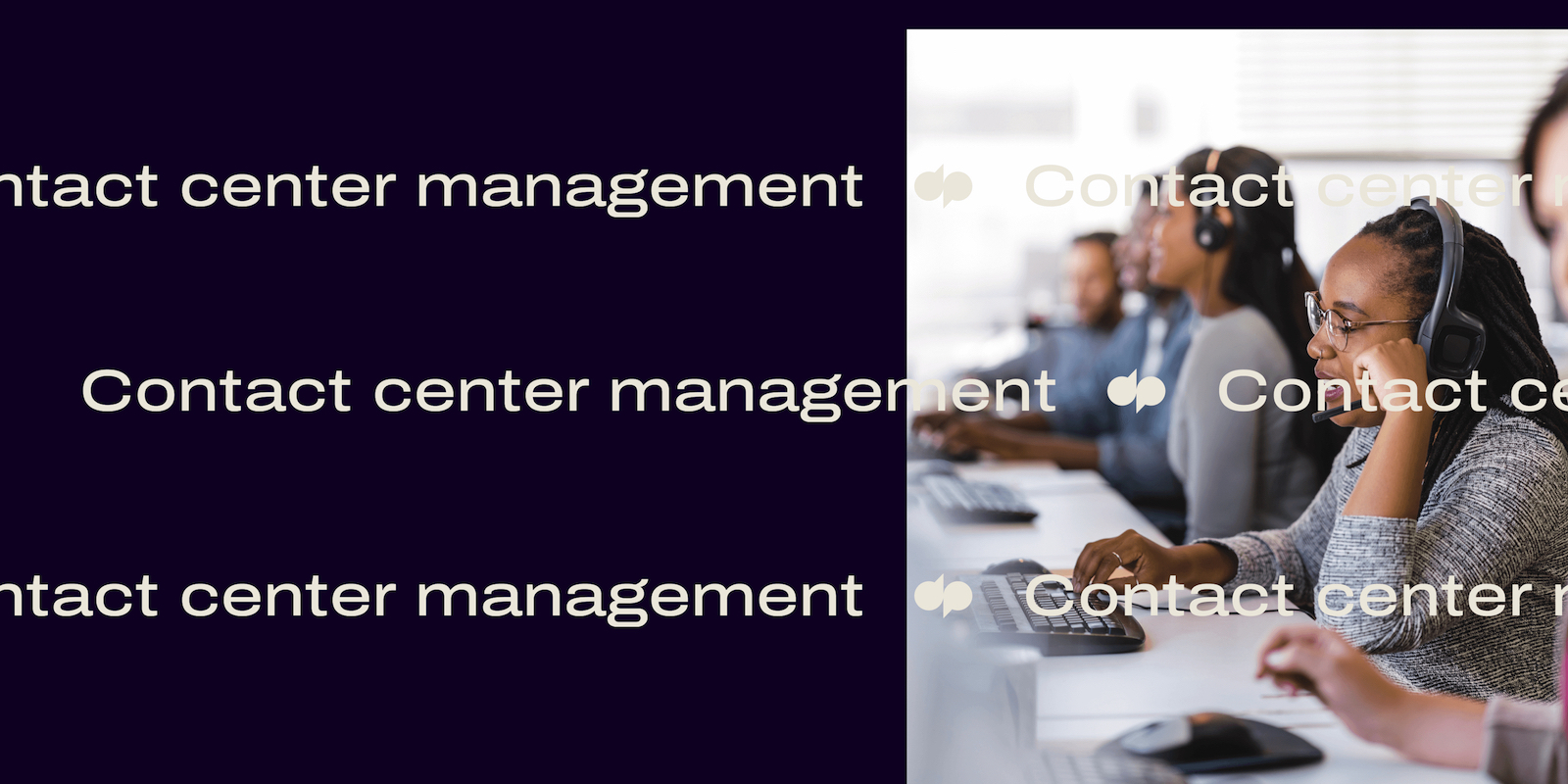
Tags
Share
The job of a call center manager is easy, right? All you have to do is schedule agents and hang around the office.
...Right?
If you yelled at your screen at some point during those first two sentences, you’re probably managing agents. I know how you feel.
And truly effective call center management? It’s much more than just scheduling and watching other people work. In this article, I’ll share some of my own experiences managing a contact center.
By the end, you’ll be ready to take the bull by the horns—or the phone by the headset, in this case—and lead your call center to success.
But first, what exactly is contact center management?
What is contact center management?
Let’s go back to the basics. Put simply, contact center or call center management is just the way your center manages daily operations. Managers keep tabs on what happens across multiple channels and touchpoints and try to mobilize their workforces as efficiently as possible to meet sales and customer experience (CX) goals.
Typically, both call center or contact center management includes employee onboarding, workforce scheduling, and customer interaction oversight, just to name just a few of the core responsibilities. Anything that needs to be handled day-to-day falls to managers to either complete themselves, or delegate.
And how you handle all of these business processes as a manager contributes directly to your call center’s success. Hey, I never said it was easy.
👉 Dialpad tip:
You don’t have to do everything yourself! There’s a lot of great tech that makes it easier to monitor and manage your call center, even if you’re one manager with a team of 20. My team uses Dialpad as our contact center software every day, especially the advanced call routing and monitoring features that allow me to be (almost) everywhere at once.
What does a successful contact center manager look like?
A call center is often a stressful, fast-paced environment. A successful contact center manager has to act as the calm in the storm. You need to be able to motivate your team—while maintaining your composure when something goes wrong. It’s a skill that can take years to master, trust me.
Bottom line: Good call center managers need tenacity and tact. It’s their responsibility to build a positive work environment and provide the best customer experience possible. All while staying within a tight budget. This is no mean feat.
4 important contact center manager skills
Successful workforce management demands a lot from managers, and there are several soft skills they should possess to flourish in the face of this kind of pressure. Taking responsibility for the well-being of agents—and customers!—requires someone with customer service experience, high levels of emotional intelligence, and strong communication and problem-solving abilities.
Let’s take a closer look at these:
1. A deep understanding of customer service
This may be obvious, but managers must be customer service experts. Even though you yourself may not be doing this every day, you must have the ability to placate frustrated customers. (After all, when a call goes south, you’re the one who’s going to jump in to help your agent.)
You also need to be able to train your contact center agents to deliver the best customer support on the most difficult phone calls. Customer satisfaction is vital for your call center’s success. And to be an effective leader, you need to lead by example. Take the time to stay updated on the best practices and track your CX metrics through your hosted contact center solution.
Fun fact: In 2020, 60% of customers in the U.S. did more business with companies that provided excellent customer service:

These agents aren’t doing all this by themselves; customer contact with managers is vital if you want to provide excellent customer service.
If you can leverage your expertise in customer service effectively, it'll lead to greater customer retention—and increased sales.
One of my favorite features in Dialpad Support is the Custom Moments. Basically, you can build custom alerts for certain trigger words or phrases (e.g. “This is terrible”) that’ll notify you when those words get spoken by a customer on a call:
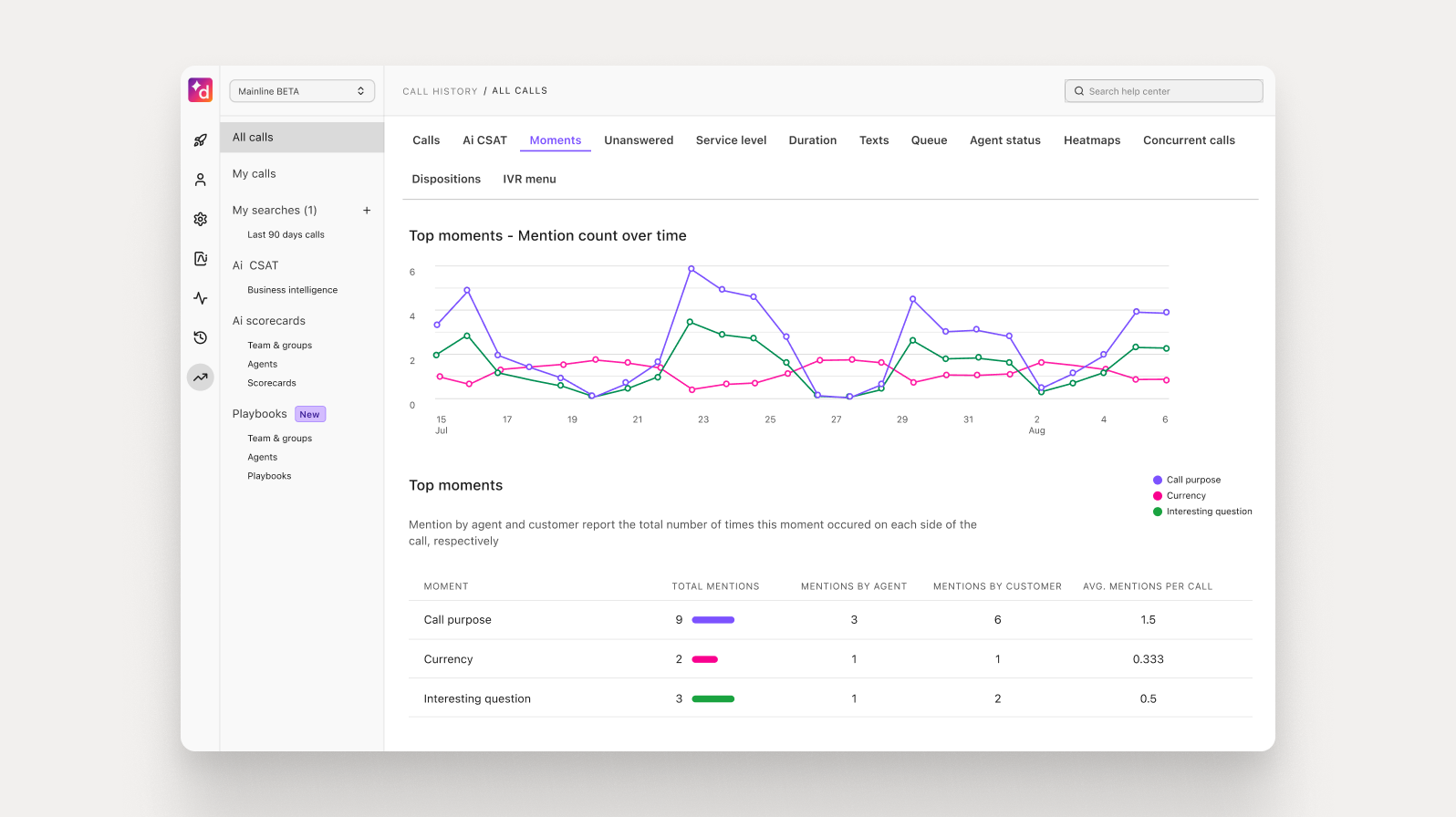
On your contact center dashboard in Dialpad, you’ll be able to see all your calls and the agent on each one. And Dialpad AI is great too because it can also pick up on the sentiment of a call. If I see that a call’s sentiment is turning negative, it’s manager escalation time:
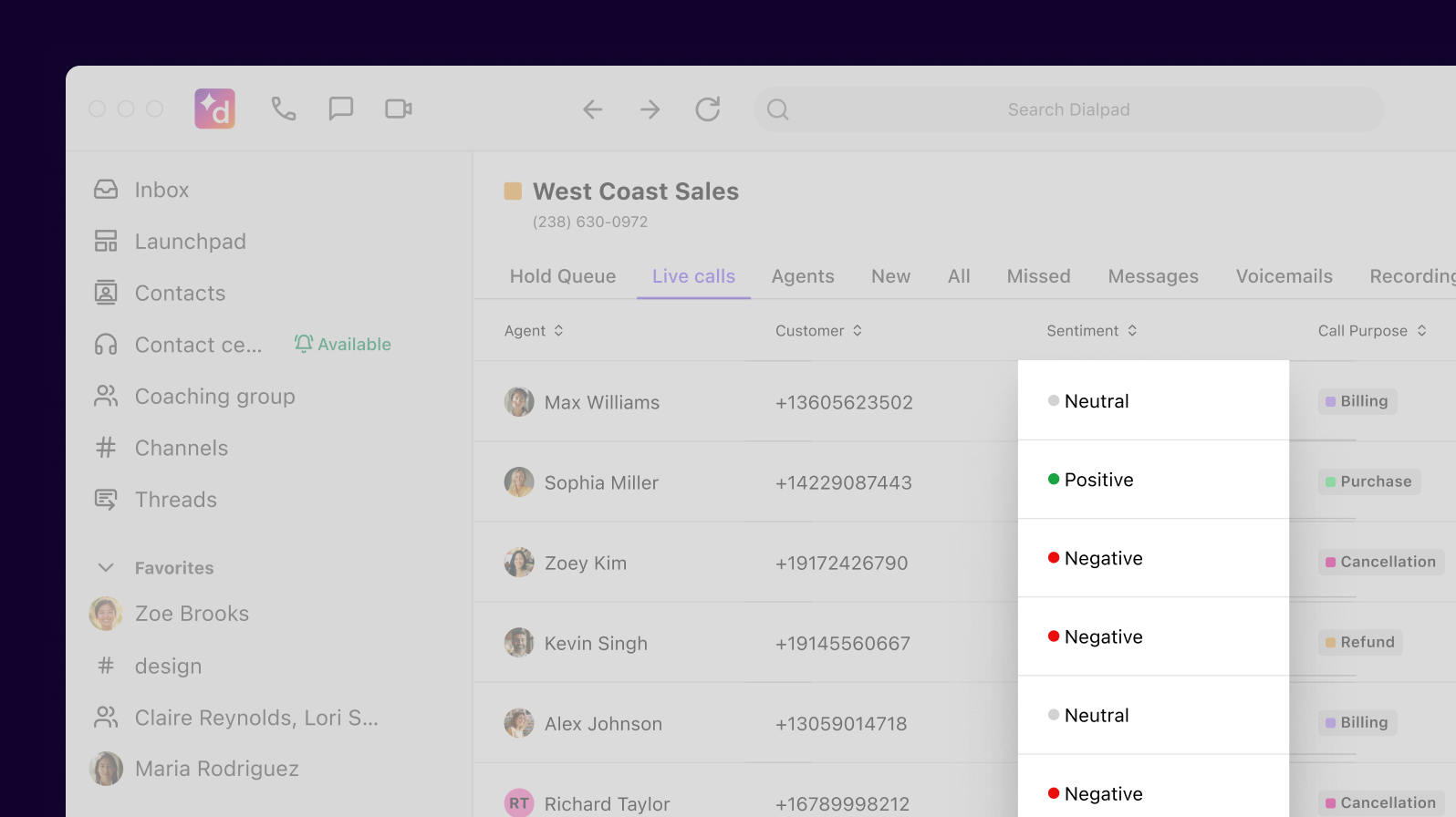
Custom Moments and live sentiment analysis allow managers like me, who are vastly outnumbered by agents on the phone, to make time efficiencies and zero in on helping the agents who need it. Not every call needs quality monitoring—but Custom Moments will direct you immediately to those that do.
Learn more about the use cases for AI in customer service.
👉 Dialpad tip:
It’s not just about manager escalation either. Let’s say your business has a cool new product or feature. You can examine what customers say or ask about it most often and build answers to these questions into your agent training material.
2. Emotional intelligence
We’ve all known someone that might’ve been the smartest person in a room—but lacked the ability to read it. As a call center manager, you need to match your expansive knowledge of your position with your emotional intelligence.
To be successful, managers need to create a positive culture and improve service levels. And to accomplish this, you need empathy, honesty, and integrity. This will help you build trust with your agents—and ultimately, improve customer relationships.
During peak hours, you’ll be in the middle of helping dozens of agents manage inbound calls simultaneously while trying to keep call wait times low. You need the emotional intelligence to deliver the same level of customer care as when you’re experiencing a lull. (This requires serious emotional stamina.)
3. Efficient communication
Do you ever feel like all you do is talk to people? With all the talking you do as a contact center manager, you must be good at it, right?
(Well, if you’ve been hired in a managerial position, you’re probably an expert in communication.) Communication is a skill you need to pass onto your agents. In a contact center, your job is to communicate with empathy and warmth—while getting information across as efficiently as possible. It’s a serious juggling act.
Check in with your team and customers to make sure you’re keeping all communication lines open and available—especially on digital channels where a breakdown in communication can quickly occur.
4. Multi-faceted problem-solving
Contact center operations require you to solve problems constantly. Agents can experience technical issues or get frustrated, customers get angry… you know how it goes. During peak times, you will have to be able to manage multiple problems, from an irate customer to call avoidance, simultaneously.
As a call center manager, your job is to keep a level head and solve all problems before they spiral out of control. (Great problem solvers know when to step in and how to diffuse the situation once they do.)
Having good, modern contact center technology will go a long way in helping you see problems developing in real-time by alerting you when service dips below a certain level:
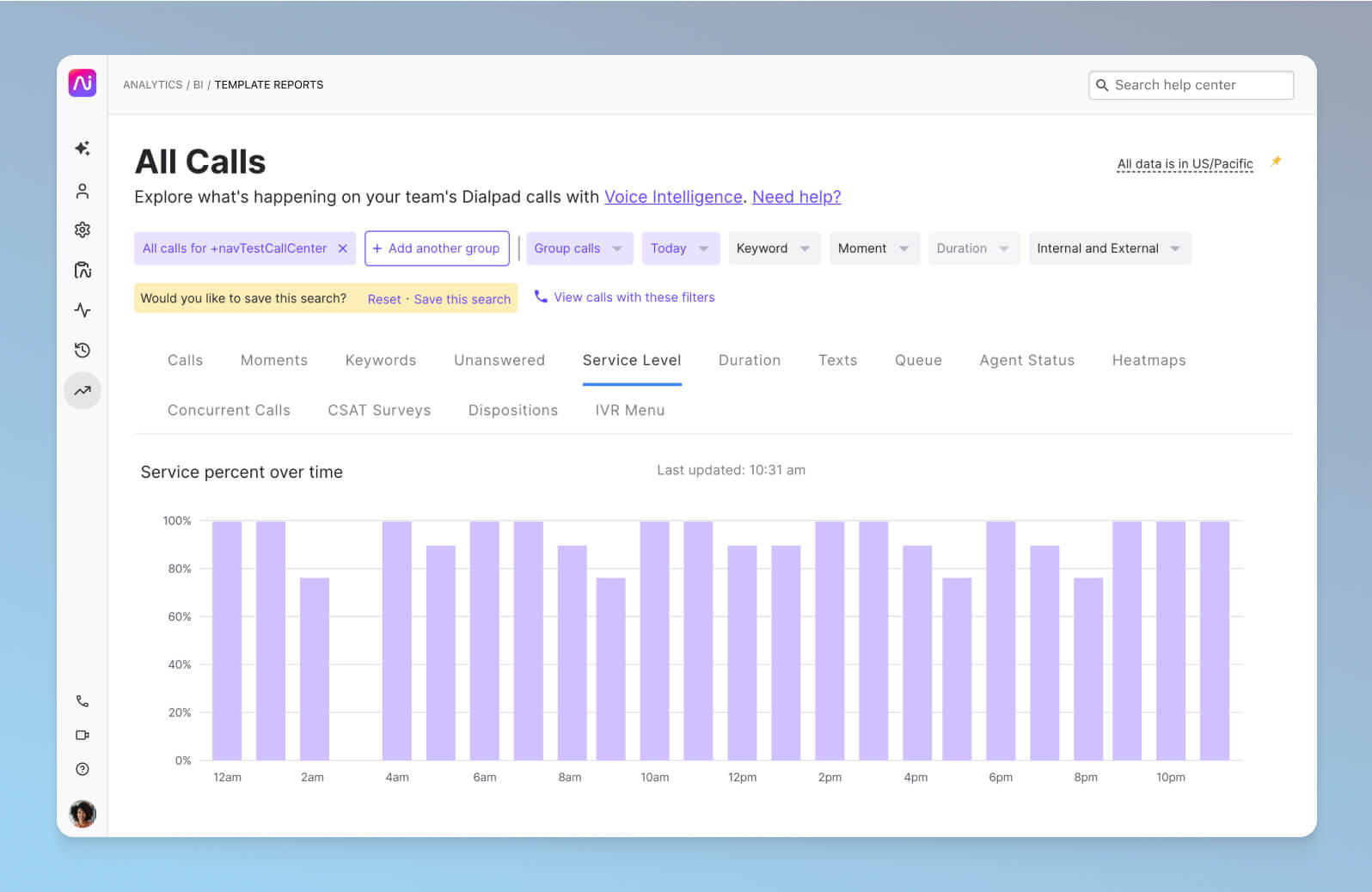
👉 Dialpad tip:
Dialpad even has an option to “monitor all call centers,” to help me keep an eye on all active calls. (We have multiple contact center teams. Fun!) As I mentioned earlier, Dialpad AI can detect sentiment changes on a call, which gives you the power to see at a glance how your calls are going. If sentiment is negative or attention is needed, it goes red, and then I’d typically look at the real-time transcript first. From there, I’ll decide to intervene or not.
Responsibilities of a contact center manager
As a contact center manager, it falls on you to:
Develop objectives and goals based on your overall goals as a company
Communicate objectives—and ensure compliance
Monitor your agents and the efficiency + effectiveness of day-to-day activities
Organize and lead team meetings
Budget and track expenses and staffing
Hire and train agents to provide excellent service for inbound and outbound calls
Motivate employees and create a positive work environment to decrease agent churn rates
Ensure that your workflow works well for your contact center
Collect and analyze call center metrics and prepare KPI reports to promote call center and workforce optimization
Okay. Now let’s look at some best practices to keep in mind.
✨ Want to improve your contact center's performance?
Grab the Contact Center Playbook, which breaks down everything you need to know, from setup to improving customer satisfaction—with examples from real contact center teams across different industries.
4 areas of focus for effective call center management
To manage a call center successfully, there are four main areas you need to focus on:
1. Agent training
An important part of effective call center management is training your agents to handle calls efficiently and effectively. There are a few key areas you should focus on when training your agents.
First, they need to be knowledgeable about your product or service. This includes answering common questions about features and pricing, and also providing support and escalating concerns if needed . That’s just table stakes.
They should also be comfortable using your contact center software. Answering calls, dispositioning them, getting a supervisor involved—it really helps here to have an intuitive and easy-to-use platform.
2. Quality management
Quality management is also a critical aspect of effective call center management. This includes setting quality standards and monitoring calls for compliance to make sure that agents are providing the best possible service to customers. Quality management is also helpful because it can highlight areas where agents might need additional training.
3. Reporting and analytics
Call center management involves a lot of moving parts, but one of the most important is reporting and analytics. After all, you can't manage what you can't measure.
Every call center manager has different metrics that they track, but the usual suspects are things like CSAT, average handle time, first contact resolution, average speed to answer, and so on.
We’ll get into more detail on analytics in the next best practices section.
4. Operations
Operations teams are the lifeblood of any contact center or call center. They’re responsible for making sure that calls are answered promptly, that agents are available to take calls, and that calls are transferred to the right department. In addition, operations managers should be able to troubleshoot any general problems or bottlenecks and make sure that the call center is running smoothly.
Operations managers need to have a clear understanding of things like capacity and be able to forecast future call volume. This will help them to determine how many agents will be needed to staff the call center and when additional agents will be needed and how to create a fair scheduling.
8 best practices for effective contact center management
From accurately forecasting team members' workloads to monitoring agent performance to promoting customer empowerment, these are quite a few pillars in an effective call center management strategy. Good call center supervisors make a point of not just giving out a bunch of work, but prioritizing their workforce's daily operations in order to help them cultivate meaningful customer and employee journeys.
As you’ve probably heard again and again, the customer experience is critical. For us, customer experience in the B2B space is sometimes even more important than factors like product and price. That means call centers need to operate in an efficient, productive manner and deliver an outstanding experience above all else.
Let’s look at eight strategies to help managers oversee their contact centers or call centers as effectively as possible:
1. Set up a cohesive plan
“Let’s just wing it and see how it goes” is not a statement that should be in your call center manager phrasebook. It will almost certainly lead to failure. You're dealing with large call volumes and multi-faceted processes—and to handle that, you need a solid game plan.
Whether you run an on-premises operation or have your agents working remotely, a good place to start is to draw up daily goals and a vision for how you want the day to go. This will prepare you to meet your targets while providing an excellent customer experience.
With Dialpad, I can easily plan through the call center dashboard. This helps me keep an eye on the service level and measure things like handle time, wait times, and call volumes in order to plan my staffing needs. Plus, there are handy heat maps in the contact center analytics that let me know our peak call times, so I can add extra staff when I need them:
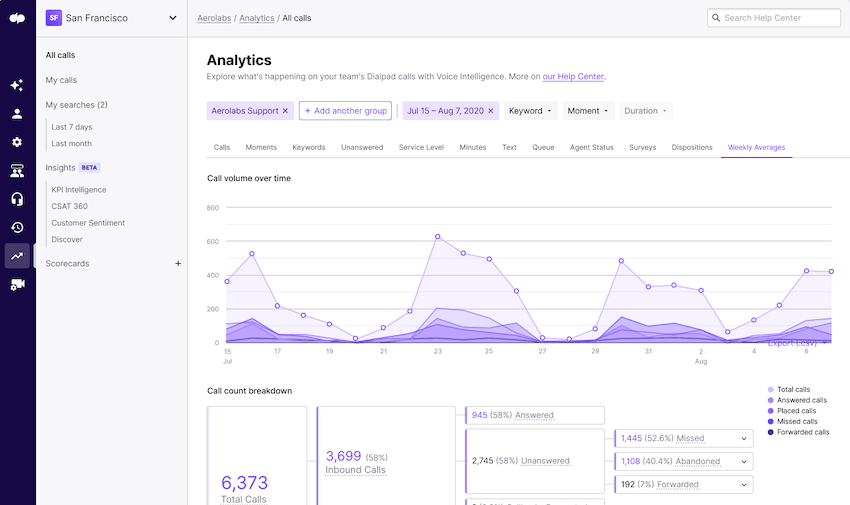
2. Provide an effective onboarding experience
Effective onboarding will turn your greener team members into tenured agents as quickly as possible. It’ll also lead to higher job satisfaction, performance, engagement, and loyalty. High employee churn rates are a huge problem in both contact centers and call centers, and this will save your company time and money by avoiding that.
(Long story short: It’s expensive when you have to keep rehiring because people quit.)
So, make sure you go over basic benefits, like healthcare and 401K information, while also providing engaging job training that prepares them to execute their job functions. Whether you use modern learning tools like games, role-playing, videos, or call simulations, look for different ways to help your agents improve their knowledge retention.
👉 Dialpad tip:
One thing to look for in call center services or software is skills-based routing, which is a critical call routing option. It takes a while for agents to master all aspects of their jobs, so giving them easy calls to start with will give them the chance to practice handling challenging incoming calls like pros.
3. Leverage the right technology
Tech has always played an important role in my call center management strategy, because as a call center supervisor who has had to oversee many agents, I’m still only one person.
Data analytics, machine learning, and artificial intelligence (AI)—all of this stuff sounds fancy and fluffy, but they’re absolutely essential for a good customer and digital employee experience if you’re tight on resources.
Anything that can make it easier for you (and people on your team) to sift through information and access customer data is valuable.
For example, in Dialpad, you can see a heatmap of not only the call volumes but also the average speed to answer. For us, having this data is important because we have a goal to pick up calls within a minute (and we’re actually at about 20 seconds right now, which is amazing):
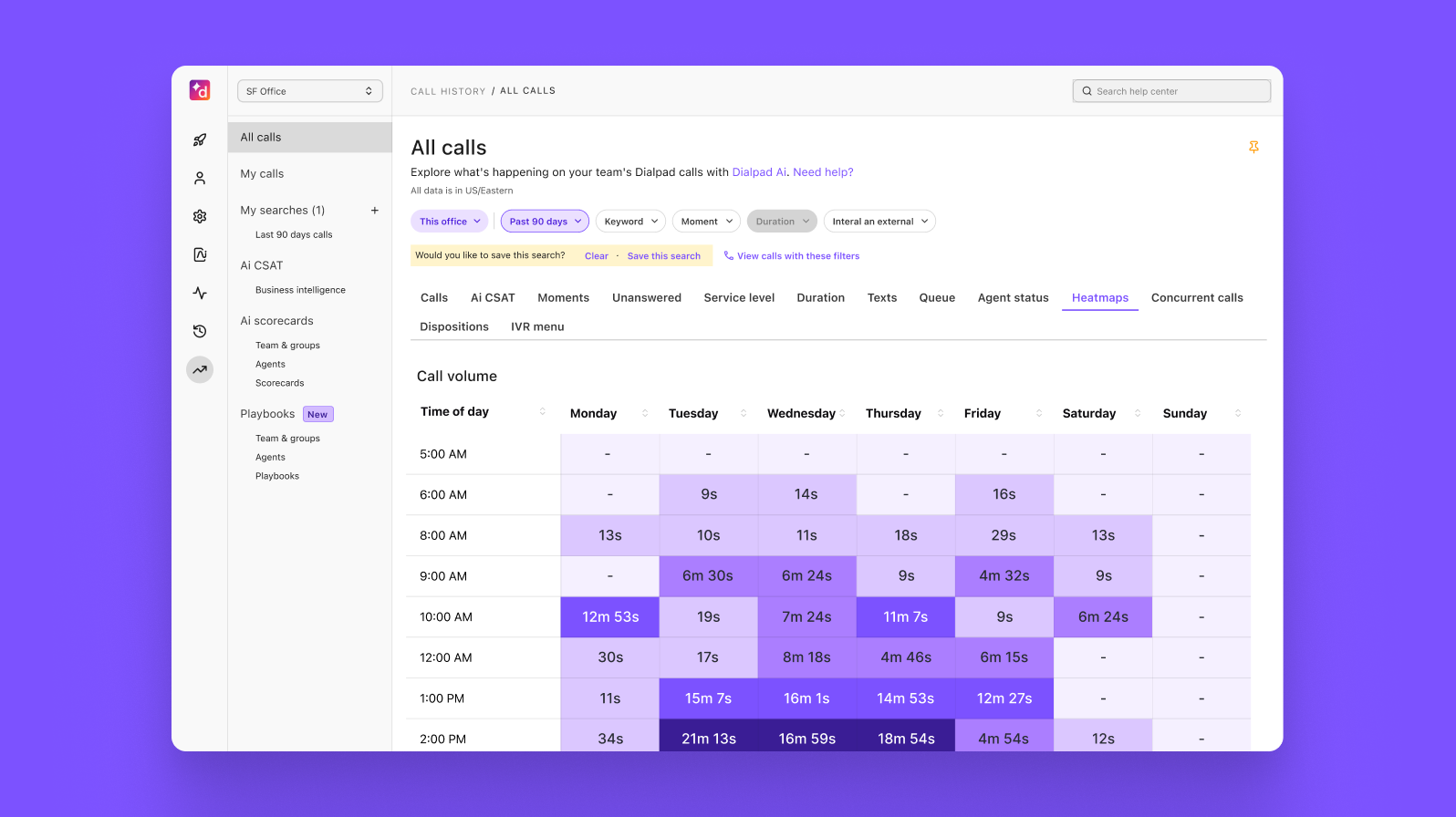
How can I staff my call center better and reduce shrinkage? How can I increase our productivity in terms of how we communicate? Here are just some of the features supervisors should look for:
AI-assisted QA and review features
With the sheer number of calls placed into a contact center across all your agents, it’s very difficult to review calls for quality and consistently provide objective feedback in a way that will help your teams succeed.
AI contact center features are incredibly helpful for alleviating some of this work! For example, we use Dialpad's AI Scorecards to help our contact center supervisors and QA teams scale call reviews and provide objective feedback to agents quickly.
Supervisors and admins can easily create a QA Scorecard right from their online dashboard in Dialpad:
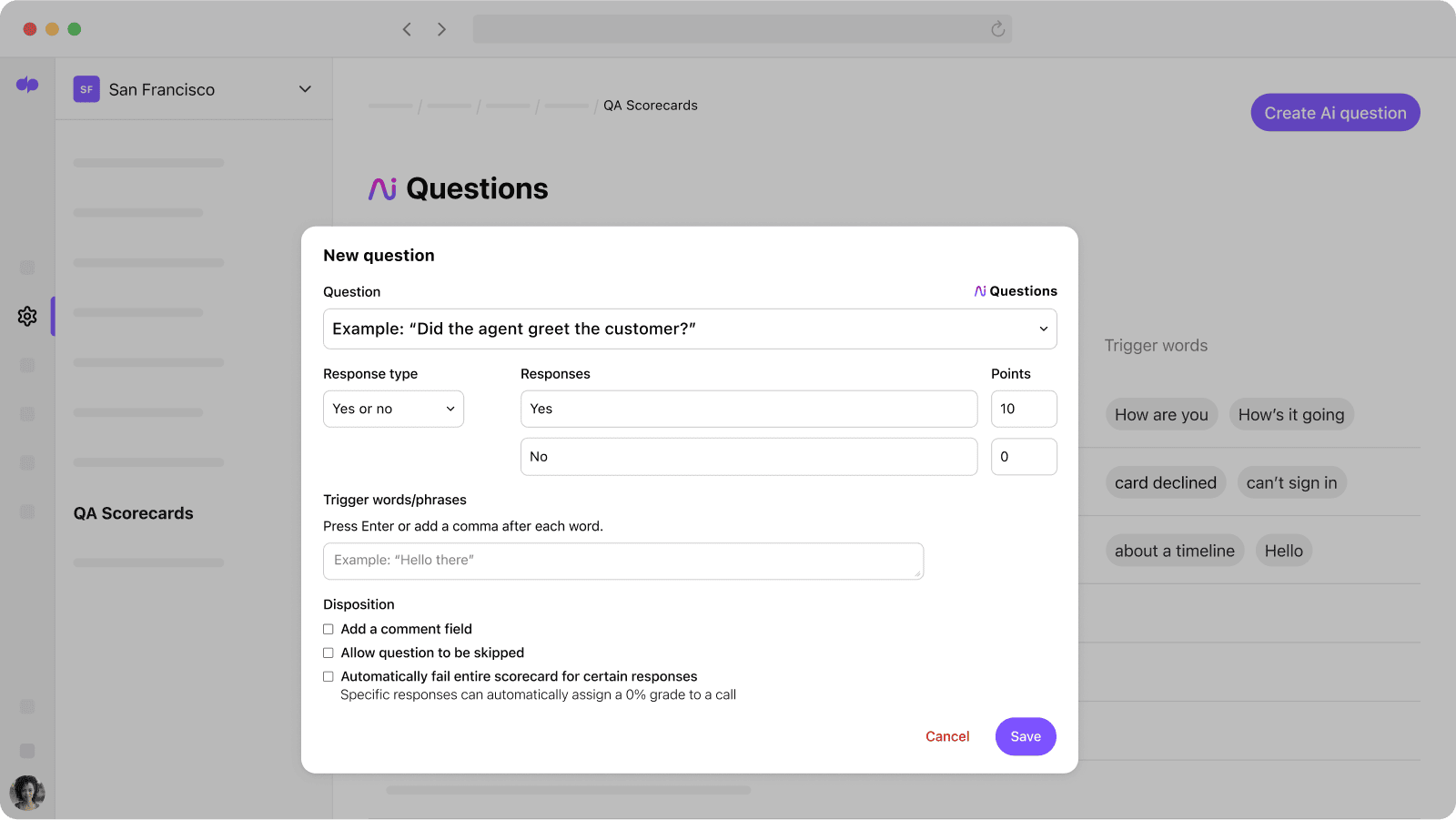
As the contact center agent handles calls, Dialpad AI listens to each interaction and automatically suggests when the scorecard behavior is met.
For example, the scorecard behavior might be “Agent asked the customer for their email ID.” If the agent asks for the customer’s email, whoever grades that call will immediately see that the activity was completed, without having to listen to the entire call recording or read the transcript.
This allows contact center teams to scale QA reviews across a much wider range of calls than would otherwise be possible—in turn, this means more effective agents, happier customers, and much improved customer satisfaction metrics.
Cloud deployment
Cloud-based software that can run across desktop and mobile devices is key if you have remote agents. To keep a virtual call center running smoothly and securely, a cloud call center platform is pretty much a must. Impossible to have that work flexibility if you don’t have this.
Smart call routing
There are different ways you can do call routing—and not all of them will work for your team. Some managers might want to assign customer inquiries based on the agent's availability, while others will want to route by skill level. In Dialpad, we have different options to choose from depending on what we need:
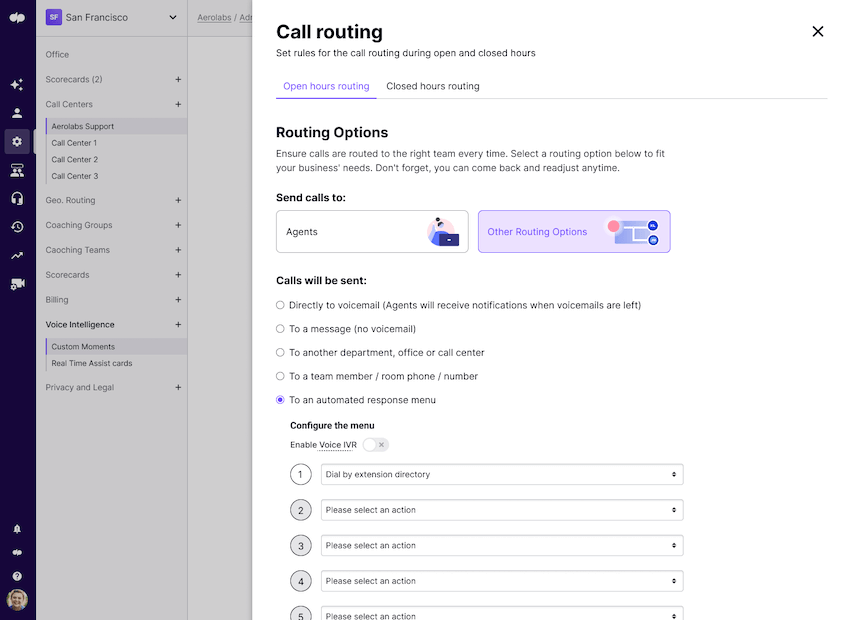
Call analytics and recording
For busy supervisors who need to monitor their agents' activity and performance, it really helps to have live dashboards that show you things like call volume, hold queue metrics, and call dispositions in real time.
Another thing that I find especially helpful is being able to capture agents' screens and access past calls in call logs in Dialpad, and being able to see how many concurrent calls there are (again, super helpful for staffing).
👉 Dialpad tip:
Every company needs different things, but if it were up to me, I’d choose a call center software that integrates all of these features. All of the other features are the cherry on top, but these are essential for a good call center management strategy (especially if you want to simplify your agents' lives and workflow).
4. Hire—and retain—the best possible staff
Managers need to put hiring agents who are well-qualified at the forefront of their strategy. That’s not new knowledge. But putting that into practice? Not always easy, especially with how quickly you sometimes need to hire.
Again, the right tech stack will allow businesses to hire call center agents from any location and give you unprecedented access to the best talent around.
In addition to onboarding a skilled remote workforce, keeping them around is just as important. For folks who are increasingly drawn to the flexibility of working from home, you might want to give them the option of using their own devices while maintaining a secure, cloud-based connection from anywhere.
👉 Dialpad tip:
The idea is to build an environment where employees feel valued—where agents receive competitive benefits, a decent salary, and a positive work experience with all the tools they need to thrive.
There's a close connection between customer experience, agent adoption rate, and employee productivity. So why not make your agents feel empowered? You'll retain more of your staff—and better engage your customers—by cultivating an appealing workplace.
5. Have a targeted coaching plan
Training and onboarding are crucial to call center agents' development. That said, the best call center management strategies should include coaching. Rather than just lecture staff about underwhelming stats and key performance indicators (KPIs), a good supervisor should embrace what we call targeted coaching opportunities. (No micromanaging!)
Targeted coaching will help agents perform better and work more independently—even in a remote setting. And we use Dialpad to do this in real time. It’s actually one of Dialpad’s biggest strengths.
For example, we review our calls regularly and try to see if certain tricky questions keep coming up. If they do—for example, if customers keep asking about a certain new feature—I can create a Real-time Assist (RTA) card with helpful tips that pops up when certain keyword phrases are said on a call:
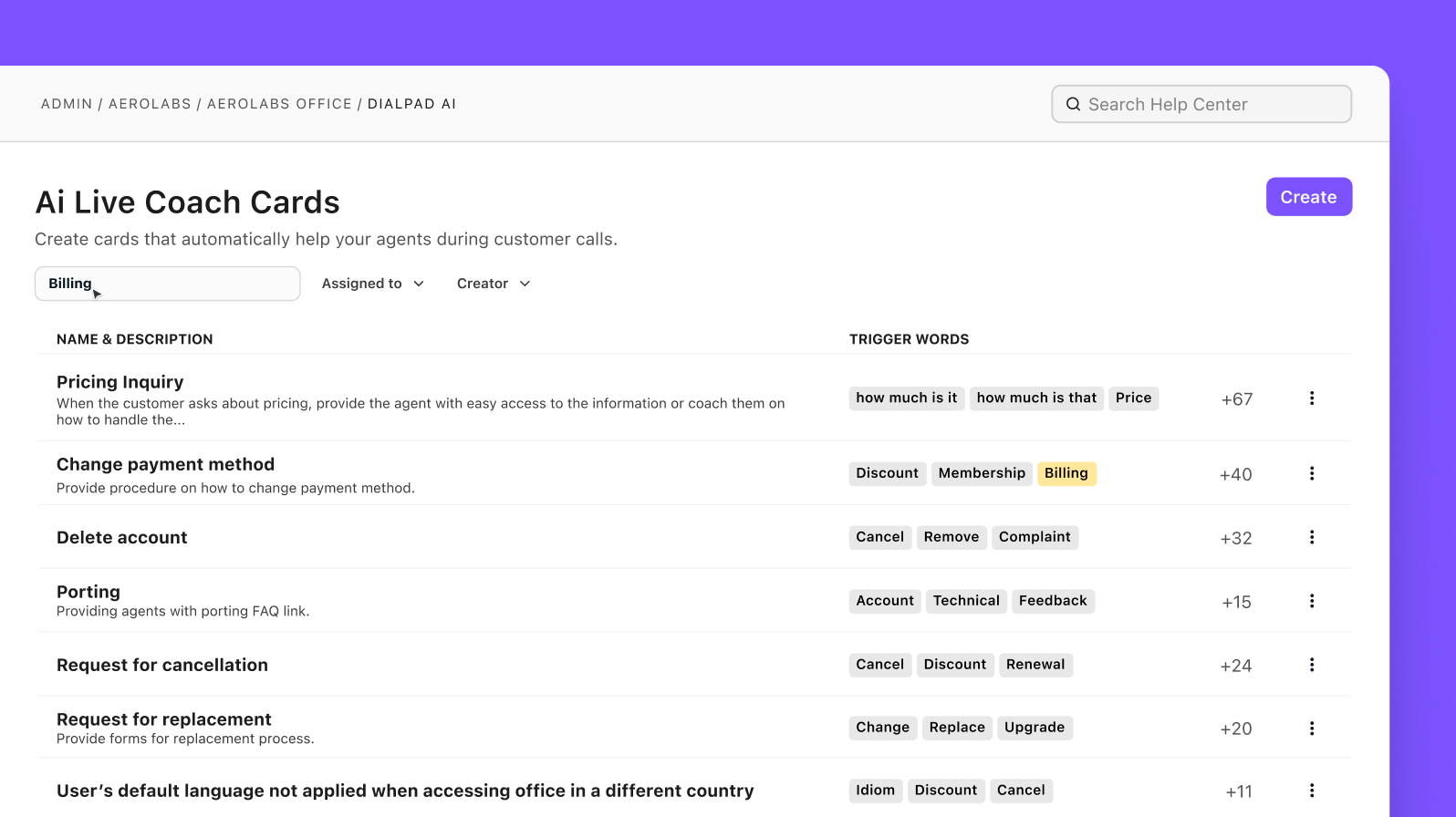
👉 Dialpad tip:
To really coach your agents effectively, call center managers should recognize that each individual has a unique combination of strengths and weaknesses (and that the agent's skill set should be at the foundation of every training session).
As a call center management team, my supervisors and I try to keep agents engaged and productive by listening in on live calls, offering recommendations based on specific keyword triggers, and being available for guidance.
Being able to coach a call in real time instead of waiting until calls are over (our memories aren’t the best after a 10-hour day asking customer questions, let’s be real) is huge. Absolutely essential for coaching.
6. Establish a customer-focused environment
Everyone talks about providing a “customer-centric experience.” It’s one of the most popular terms in recent years.
The concept is simple enough: consumers today are more informed and less loyal than their predecessors, which makes it critical to make the customer experience your competitive advantage and find ways to make your call center a key strength.
In simple terms, customers have come to expect high-quality, fast service. Having a user-friendly product helps us a lot, but beyond that, we set our goals based on how quickly we can solve our customers’ problems. (For example, can we minimize the time they have to wait on the phone when they call us?)
If you haven't already, consider implementing chat and email responses for your support teams in a cohesive way. One tip for call center managers is to make sure their phone system integrates with their ticketing system to save time when customers contact their agents.
The idea here is to be quick and efficient—disruptively so—and make your contact center so effective that it’s a reason that your customers stay with you and choose you above your competition.
7. Outline your goals and make sure everyone understands them
Some managers prefer to leave agents to their own devices. This approach, however, doesn’t work well for call centers in my experience.You don’t want your agents to wing it only to find later that they’ve lost a significant client.
The good news is that supervisors can act strategically to improve their contact center management strategy. The key is to outline your organization's goals and this is the important part: make them accessible.
As a leader, you should know the challenges that your organization has experienced in the last quarter. But your team may not know these goals, so how can they help you generate potential solutions for each one?
Ultimately, the objective is to fuel continuous improvement. Following every decision or milestone with a game plan—a plan where call center managers and agents can join forces and leverage their strengths—is an ideal next step.
👉 Dialpad tip:
As a contact center manager, your secret weapon is your receptiveness to agent feedback. (Understanding this feedback also helps you delegate tasks to team members throughout your goal-setting process!)
8. Have an omnichannel platform
Generally, businesses with more robust customer engagement tactics retain more customers than their non-omnichannel counterparts. (But that depends of course on how many channels your customers use to reach you.)
By going omnichannel and building a sound presence online and offline, you can let your customers easily interact with your call center using their preferred method.
For instance, many call centers—rather than assigning social media to a different department—have begun to view social media sites as a customer service tool and respond to customer queries in real-time.
👉 Dialpad tip:
The thing to remember here is you have to be accessible on the channels that your customers want to reach you through. It’s a basic, but key thing managers can do to help drive customer engagement and loyalty.
If your call center uses different tools and platforms, look for ways to integrate those apps together—it can save you a ton of time.
For example, with Dialpad's integration with Zendesk, agents and managers can place or respond to calls, surface recommendations, and log events to customer profiles—right in the Zendesk platform. Sounds like a win-win, right?
(Another benefit of having an omnichannel presence is it gives everyone on your team a birds-eye view of customers, which means they won’t have to repeat themselves so much.)
8 bonus contact center management tips
1. Prioritize employee engagement
No matter what industry you’re in, engaged employees make for happy customers. Workers who are invested in their jobs develop stronger customer relationships, resulting in higher profits and better customer service outcomes.
For example, you can make your agents more invested in their own performance by showing them how to look at analytics and use technology like CRMs.
The more your employees feel empowered, the more they can help make your job easier. For example, if they notice patterns in callers who are asking the same questions, they might suggest that you adjust your interactive voice response (IVR) menu to help people find answers themselves.
Happy employees aren’t just better at staying engaged with customers and providing the best service, they can also help you!
2. Foster a coaching culture
To embrace targeted coaching, as I mentioned earlier, you need to foster a strong contact center coaching culture first.
You don’t want to be up in your ivory castle as just the overseer or the disciplinarian. As a manager, you’re most valuable to your team as a leader and a coach. So, develop a coaching culture where your team feels like they can come to you for anything—because they truly believe that your job is to allow them to shine in their role and to solve any problems.
Now, fostering this kind of culture isn’t a walk in the park. It requires regular and open communication. I’ve found it helpful to use omnichannel… to coach! What does that mean?
Well, our contact center managers can use Dialpad’s messaging feature (you can use any team chat solution) to send messages directly to agents. For example, if I can see that one of my agents is on a difficult call, I can read the real-time transcript for the call and message them with some tips while they’re on the call to help turn things around.
3. Provide consistent and continuous training
We can all improve in how we run contact centers, every day. And regular training is so important because it acts as a refresher and a skills booster for all your agents.
When you are doing this, don’t forget about training on your automated systems, like your self-service call and chat features! Even though these are technically run through IVR and chatbots, your agents should have the knowledge they need to interact with automated systems effortlessly and provide that seamless customer service.
4. Have two-way feedback sessions
In terms of employee engagement, feedback sessions are essential. They’ll make your employees feel heard and more invested in the center’s success. Getting feedback is also a great way to improve your call center performance and workflow.
Sometimes, the best people to solve operational problems are the ones who work in the trenches. (Can you tell that this is a huge part of my contact center philosophy?)
5. Use call monitoring checklists
What manager doesn’t recognize the power of a good checklist? Call monitoring checklists are useful because it gives you a systematic, efficient way to spend one-on-one time with your agents. At the same time, these checklists will allow your agents to get valuable positive and constructive feedback to get better at their job.
A good checklist allows both you and your team to get better at your jobs, whether it’s getting a feel for what agents need in terms of additional training or what features need to be changed in your call center software to improve the workflow.
6. Handle conflicts right away
Never let conflicts fester. If there’s a problem, deal with it head-on. You can always prevent conflicts, but actively seeking out areas of potential conflict and swiftly intervening will likely stop many in their tracks.
This is huge because if I can influence behavior while my agents are on a call, that usually has a much greater impact than if I wait until after it’s over.
In all cases, of course, use your good judgment and be decisive when dealing with customer or internal conflicts.
7. Promote empathy
This seems like a basic thing, but I’m always surprised by how rare it is to see a contact center team that practices this.
It’s absolutely vital to promote empathetic customer service and encourage empathy—and it all starts in your team interactions. Customers can tell (quickly) whether or not the person on the other end of the phone cares about them.
I don’t have to tell you that showing compassion on calls improves customer engagement. Just because your customers show up in your system as a ticket and phone number doesn’t mean they should feel that way!
Adopt empathy as a core value in your call center. Make it a part of your hiring and training process, and lead by example.
8. Never neglect ergonomics
Okay I had to add this one in because it’s extra important for teams that are working for long shifts! Especially if you work on-premises, don’t forget about the design of your workspace. It can provide a healthier and happier employee experience. The result? Better performance, higher productivity, and better employee retention.
Improve your contact center management with AI
Armed with all the knowledge, skills, and tips you need, you’re ready to take your call center management to the next level.
Make sure you have a plan in place to empower those amazing agents at your side. Leverage technology, know how customer service AI can help both your supervisors and agents, and make your contact center a fantastic place to work.
Remember, you’re not alone.
Need software that helps your manage your contact center?
See how Dialpad Support is designed to do just that. Book a demo with our team, or take a self-guided interactive tour of the app first!
